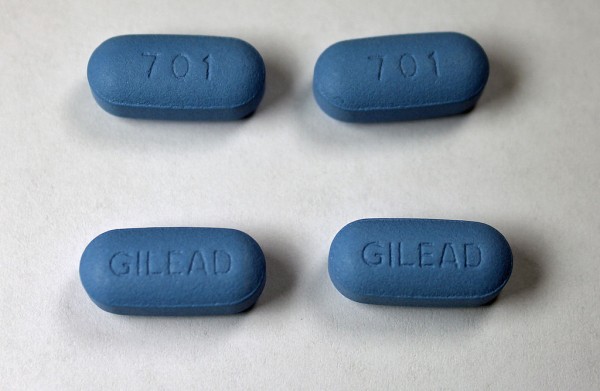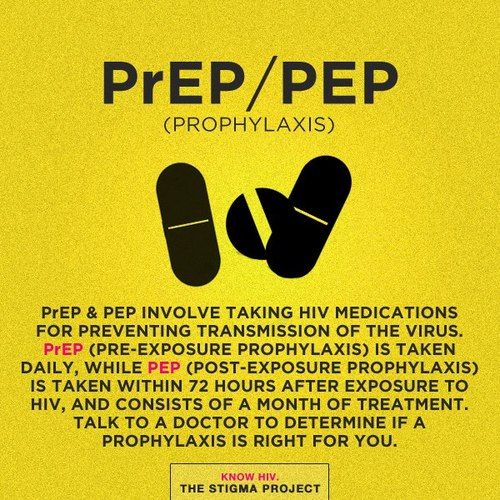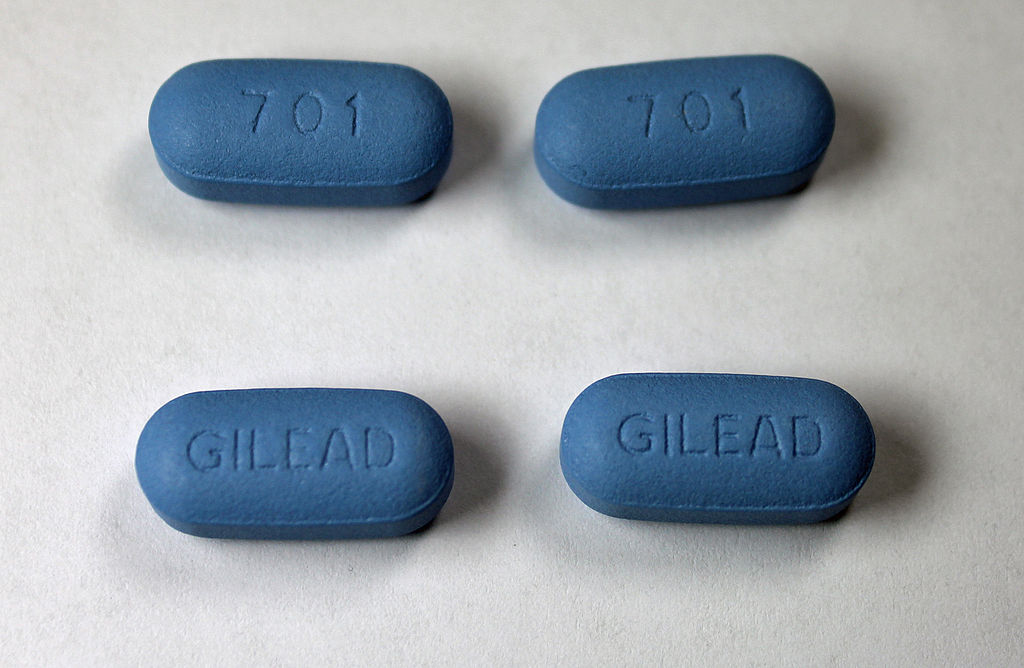
Lindsay Roth cowrote this post with sex worker ally and colleague Cassie Warren. Roth and Warren work together at PxROAR (Research, Outreach, Advocacy, and Representation), a program for community activists which offers training and support around biomedical HIV prevention research and advocacy. Readers can contact them with questions about PrEP at lindsay@swopusa.org and cassandra.r.warren@gmail.com.
So you’re telling me you can take a pill to prevent HIV?
Yup. We believe that if done right, PrEP has the potential to be one of the best tools brought to market for receptive partner protection and power since the pill in the 1960’s. PrEP doesn’t double as a contraceptive, but it does reduce your risk of HIV by 90% when taken correctly. It’s still a sweet tool to have in your make-up bag, hard femme box, tool kit, whatever you call it. We are still in the middle of an epidemic, with trans and cis women, men who have sex with men, and injection drug users still being hit hard and unjustly. We deserve to have access to all the options that protect us against HIV.
In what follows, we’d like to lay out the basics of PrEP (no really, what is it? does it cost the first month’s rent?), add context to some of the controversies, and offer our take on what this means for sex workers. We do not anticipate that we’ll be able to answer all the questions people have in this one post, and we hope that you will comment or reach out to us directly if you’d like to know more.
What the heck is it?
PrEP stands for Pre-Exposure Prophylaxis. The main part to note here is “pre,” implying treatment before exposure. In this context, we are talking about exposure to HIV (Human Immunodeficiency Virus). So, PrEP is a medication an HIV-negative person would take to prevent them from becoming positive. Currently, Truvada is the only form of PrEP approved by the Food and Drug Administration.
Truvada is an NRTI (nucleoside analog reverse transcriptase inhibitor) which is just a fancy name for an HIV medication. It has been used to treat HIV since 2004. We used to know HIV as the virus that caused AIDS, and knew AIDS as a death sentence. However, because of advancements in the treatment of HIV, positive folks can live long, healthy lives. Folks can even be positive, on treatment, and unable to transmit the virus to anyone else. Recently the medical establishment stopped giving AIDS diagnoses: Because of new treatment options people can be at various stages in their HIV diagnosis, and we now classify HIV as stage 0, 1, 2 or 3 HIV.
Many readers may be familiar with PrEP’s sibling, PEP, or post-exposure prophylaxis, the use of antiretroviral drugs—ARVs (again, a fancy name for HIV medications)—to mitigate the risk of HIV transmission after a potential exposure. Any doctor can write a prescription for PEP, most Medicaid programs pay for it, and Gilead, the large research based pharmaceutical company which makes Truvada, has a patient assistance program to cover the the costs for the uninsured or underinsured, regardless of immigration status.
To summarize, PrEP vs. PEP:
- Truvada as PrEP is taken before an exposure to HIV, specifically one pill a day, every day.
- PEP is taken after an exposure to HIV, specifically within 72 hours, and consists of 30 days of full-regimen HIV treatment medication.
- Both prevent you from acquiring HIV.
How does PrEP work?
The rationale behind PrEP is based on the way most doctors are treating HIV-positive individuals with ARVs. Truvada is a combination of two medications, tenofovir and emtricitabine. If HIV is presenting itself in one’s body, this medication blocks the replication of HIV in the body. Doctors currently prescribe one pill a day, as the medication must be present in the body to do its work. However, there are trials underway to test the efficacy of other ways of taking PrEP. So far, the results of the iPrEX OLE (open label extension) say that if you take it 2-4 times a week you are protected 85% of the time against HIV, and if you take it 5-7 times a week, you are protected 99% of the time against HIV (not other STIs or pregnancy). If you take it less than 2 times a week you have zero protection. 1
Can I take it right before I meet a date?
No. PrEP acts like a full metal jacket around your T-cells, so if HIV is introduced to your body it can’t get into the cells it wants to infect and replicate itself.2 It takes about seven days to make this metaphorical metal jacket around the cells in the rectum (drugs taken orally are absorbed quicker in the digestive track), and about 20 days to make a metal jacket around the cells in the vagina (our apologies if you call your junk something else) and in the bloodstream. So, for full protection, you’d need to be taking it every day for a week before you’re protected during anal sex, and every day for three weeks before you are protected during vaginal sex or during any activity in which you would share blood (e.g., sharing needles for tattoos, hormones, drugs, piercings, etc.).

Talk nerdy to me.
There have been several trials on tenofovir-based prevention modes. This includes pills, like Truvada (which again, also contains emtricitabine), but also gel forms, called microbicides. There are campaigns for vaginal and rectal microbicides as another PrEP option to reduce HIV transmission. 3
There have been four trials that found PrEP to provide protection from HIV in sexually active men and women (Partners PrEP, TDF2, iPrEX), as well as men and women who inject drugs (Bangkok Tenofovir Study)4.
Even with great data coming from these clinical trials showing that “if you take it, it works,” there are some folks against it. Media coverage on PrEP often cites the FEM-PrEP and VOICE trials, which were done specifically on cisgender women with no success. Without writing a whole separate post about these studies, we’ll summarize by saying that the adherence of the women enrolled was too low to determine if the medication was effective, and analyses of these studies are currently being completed. Essentially, the researchers didn’t consider some important factors about cis women (who’s surprised?) and they were not able to gain any reliable data because the women enrolled in the study were not taking the drug enough to collect any data on if it was actually working or not.
The PrEP studies that showed efficacy (reliable data that it works) were inclusive of cis men and women and some transgender women and were conducted both in the U.S. and abroad (mainly in African countries). There is, however, a dearth of data on how PrEP impacts U.S. cis women, as the only domestic study was the iPrEx study that focused on MSM and transgender women. The U.S. Women’s Working Group on PrEP has been working hard to bring awareness to this issue. We believe that if done right, PrEP has the potential to be one of the best tools brought to market for receptive partner protection and power since the pill in the 1960s. And while (right now) PrEP doesn’t double as a contraceptive, protecting against HIV even 85% of the time (for those at the lower end of adherence) is still a sweet tool to have in your make-up bag, hard femme box, tool kit, whatever you call it. We are still in the middle of an epidemic, with trans and cis women, men who have sex with men, and injection drug users still being hit hard and unjustly. We deserve to have access to all the options that protect us against HIV.
What are the side effects or collateral consequences of PrEP?
Truvada’s most common side-effects are nausea, headache and diarrhea, however these wane over a few weeks- or at least that’s what a handful of the clients I see experience, but some don’t experience side effects at all. Truvada can be tied to small decreases in kidney function but these are temporary and stop when PrEP use is stopped. Regular kidney monitoring is recommended with Truvada as PrEP. All follow up studies on kidney impact have shown that for the folks who did have problems with their kidneys, it wasn’t life threatening, and after a couple of weeks those folks chose to go back onto Truvada. Thinning of bones is another more serious side effect. This too is not so common but needs to be monitored for.
Additionally, Truvada is considered the backbone of all modern HIV-treatments and millions of individuals living with the virus take it as a life sustaining medication every day with non-life threatening side effects. As of June17, 2014 over 164 leading HIV/AIDS organization and 132 individuals signed on to reiterate their support of PrEP under the 2012 CDC guidelines. There is indeed great concern over the long term impact of PrEP, and it is too soon to tell what that may be. Anecdotal testimony from bloggers like this indicates that they have been healthier while on PrEP and that it provides motivation to stay on top of their health through regular testing and doctor visits. Although for us, the idea of clinic visits does send up red flags.
What strikes fear in my little junkie-hooker heart is just how much you have to interface with healthcare professionals to get on PrEP. I don’t think I could personally stand the potential shaming involved. Plus, lots of non-HIV specialized providers don’t even know what PrEP is. That’s why it’s important to find a good provider, which we know can be difficult, especially depending on where you live. Message us if you want some support with finding a provider or with getting materials together to bring to your provider about PrEP.
What does the process of obtaining the pills from a (knowledgeable) provider look like?
At the clinic I work at, it involves two appointments before you have the prescription in hand, then follow up every month for the first two months, then every three months (though every provider is different). The reason it’s every three months is because it’s important to test for HIV while on PrEP. This will prevent drug resistance if someone has acquired HIV.
During the first visit, you’ll talk about why you want to be on PrEP—they’ll ask you questions about your sexual practices and your drug use to assess your level of risk. If you don’t want to out yourself as a sex worker or an IDU, you could say you are in a monogamous relationship with a person who is HIV positive and you want to have an added layer of protection.5 You and the provider will have a discussion about what being on the medication looks like. Then they will take four small tubes of blood. Why all that blood? Folks on PrEP are monitored through regular HIV-testing and testing of the kidneys, liver, and other vital organs. During the second visit, when the results of your blood work are back (usually a week), you’ll discuss those results with your provider and then they will write you a prescription. Again, at the start, some providers may write the first prescription for one month, and then if PrEP works for you and your vitals come back normal after the first month, they’ll move to three month prescriptions.
How do I pay for PrEP?
There are a number of ways to obtain PrEP. Truvada is already covered by most private insurance plans and Medicaid. For folks with high co-pays or who are undocumented/uninsured, Gilead has two patient assistance programs to cover drug costs. PrEP will be more accessible if you go to the folks who know about Truvada as PrEP and are willing to prescribe it, which are typically HIV clinics, or clinics with a HIV, LGBT, or a community health focus.
So why should we care?
Some of you reading this may never have considered PrEP, and some never will. Which we totally support—we’re not trying to hustle to get everyone on PrEP, nor are our broke asses getting pharm money. We just want folks to know what options they do have to reduce risk, and to have some of the political framing; it’s always political. PrEP gives us an opportunity to advocate for sex workers’ rights. And I know we don’t always agree, but even with our different approaches PrEP still provides a lot of leverage and legitimacy, especially in the current HIV climate. The conversation about biomedical HIV interventions is not going away, and regardless of individual opinion, the folks at the top are still lumping us all into one category and labeling it “high risk” or “key population.” Meaning, they are going to target us, or in a more strategic move for us, they are making us a priority. If they’re making us a priority “to address” us as a “key population,” we should be at that table.
In other countries, especially where different legal frameworks allow sex workers to be more visible, PrEP is being studied specifically on sex workers. NSWP (Global Network of Sex Work Projects) has responded to this practice with several pieces that acknowledge the potential risks and benefits of PrEP for sex workers. The articles make it clear that sex workers need access to knowledge about PrEP, as well as engagement in policy and related programming.
In our opinion, in order for biomedical interventions to successfully impact sex worker communities, they must address two main concerns: The general disparities that sex workers experience in medical settings and the need for expanded access to biomedical interventions like PrEP in clinical settings.
There are several ways in which medical communities can better serve sex workers:

1. Sex workers must be at the table.
When it comes to HIV prevention in the sex industry, sex workers know best. Our insight is one of the medical community’s greatest assets as we develop effective interventions. Sex worker-led organizations from the global to the grassroots levels have been stakeholders in reducing HIV transmission by ending the stigma and criminalization of sex work. Domestic medical providers can consult with local sex worker-run organizations or “Pros Networks,” create advisory boards, hire current and former sex workers as staff, and work to include participant input in their programming. Creating a space for sex worker advocacy will create better interventions.
It should be noted that the sex industry is large and diverse and not all individuals engaged in sex work or survival sex work will identify with those terms. It is important that organizations create a safe space free of judgment, criminalization, or diversion, where individuals who trade sex feel safe self-identifying and self-advocating.
2. More U.S.-based participant informed research about sex workers
Good data on sex workers is scarce, especially in the U.S., largely due to the criminalized nature of sex work here. Participant-informed research will encourage sex workers to feel safe participating in studies that can better articulate the landscape of sex work in the U.S. As we well know, sex workers have many other needs beyond HIV-related ones. It is our recommendation that in order to encourage interest and buy-in, biomedical prevention must be packaged in with other needs articulated in a patient-centered practice. Again, patient-centered practices are best achieved with the institution of safe spaces. These should be combined with holistic, harm reduction oriented outreach, which has historically been successful at reaching the most marginalized of sex worker communities. Furthermore, we must consider more broadly what access to PrEP means, not only for sex workers, but for many populations marginalized by the medical community.
3. Expand mobile testing to make PrEP more accessible.
There’s a paradox involved in making PrEP available to especially marginalized populations who may not engage medical care because of stigma, unique logistics, or both: Providers who have the legal ability to prescribe PrEP (e.g. MDs, CRNPs or PA-Cs) oftentimes do not have adequate practice settings (logistical accessibility, adequate harm reduction counseling skills, opportunities for routine follow up and monitoring), whereas those providers who do have access to relevant patient populations, viable logistics, lower cost of services and likelihood of patient engagement (i.e. community based testing sites staffed by licensed HIV testers, nurses, and/or social workers) do not typically have staff present to prescribe this medication. This means that PrEP is not reaching the populations who stand to benefit the most from it, including sex workers and survival sex workers.
There are several things that medical providers can do to facilitate PrEP access. PrEP could become more accessible to clients if clinics considered changing their logistics. For example, clinics could stay open later or help with transportation, create safer spaces by using affirming language (e.g. appropriate gender pronouns) and staff the practice with representatives from the populations they wish to serve (for instance, hiring transgender testers to work with a transgender population). Mobile testing units have been successful domestically in testing individuals, 6 and this model presents an opportunity from which we can deliver other interventions, including PrEP.
There are a number of possibilities that would increase awareness of PrEP in sex worker communities, a community that has historically been met through outreach efforts. Mobile testing units literally “meet people where they are” and help remove barriers from engaging in care. This model of HIV testing could be a realistic way to meet individuals who are lost to medical care but who could benefit from PrEP as a prophylaxis and a re-engagement tool.
Most medical sites would require a more robust staff. Staff providers able to write for PrEP would be necessary, as well as social workers or trained peer workers who could help individuals enroll in insurance or patient assistance programs, and discuss risk reduction. Expanding prescribing authority to nurses for Truvada is another option that would allow low-cost interventions to meet the needs of individuals who may work in nontraditional settings, such as sex workers.
Time will tell what PrEP, microbicides, or even an HIV vaccine will mean for sex workers. What we can expect is that policy makers and HIV service providers will continue to target domestic sex workers as “high risk” and “key” populations. And we should be PrEPared (see what I did there?) with the facts about these interventions so we aren’t always on the defense, but can have a seat at the table to advocate for what we think PrEP should mean for sex workers.
We can use the dialogue being generated by policy makers, the medical community and the media around biomedical HIV interventions, like PrEP, to push a comprehensive and intersectional agenda around sex worker health and safety. We all know that criminalization is what renders sex workers “high risk,” and interventions like PrEP do not mitigate this. However they do give us a legitimate platform to discuss these issues with policy makers, scientists, and healthcare workers.7 And, this is buzzing so hard in the HIV movement right now—lots of national and international organizations (Amnesty, the World Health Organization) are making recommendations for countries to decriminalize sex work. Of course, we’d like more discussion of anti-criminalization, but starting the PrEP conversation means getting invited to other dialogues. And there is an opportunity here for some strategic moves. If you’ve got ideas, we’d love to hear them. If you want to know more about PrEP for your possible personal use, please reach out. We both are available to respond to comments and hope this information helps answer questions about PrEP, as well as provoking more discussion.
1. http://www.aidsmap.com/Overall-PrEP-effectiveness-in-iPrEx-OLE-study-50-but-100-in-those-taking-four-or-more-doses-a-week/page/2892435/ ↩
2. Check out a video that illustrates this process here. ↩
3. We both work with an organization, AVAC, which is tracking research on PrEP. You can find great information here: http://www.avac.org/prep/track-research ↩
4. http://www.avac.org/prep/track-research ↩
5. Also, here is a list of the CDC guidelines for providers and there is now a hotline for providers to get information. ↩
6. In Philly, for instance, there has been great success in testing through these measures. ↩
7. Additionally, Michael Weinstein for AHF (AIDS Healthcare Foundation), yes, that same guy who is trying to get condoms in porn, is at it again, using PrEP as a battleground for his respectability politics. He believes the only HIV prevention that should be used is condoms, an option which is not feasible, accessible or even desired by all. There is a petition for his resignation. ↩

I haven’t been able to find a doctor willing to prescribe Truvada. Do you happen to know of any in Central Florida?
I know PrEP is a contentious issue with a lot of the key decision makers in Fla. According to PrEP Watch (http://www.prepwatch.org/prep-access/local-programs/) there are no programs for PrEP, but that doesn’t mean it is not being prescribed. It might take educating your primary care provider -check out resources here (http://www.projectinform.org/prepresources/), or feel free to reach out to Cassie or I directly for support.
Can I suggest a text explaining the risks of PrEP for sex workers?
This article looks like the promotion of a medication toward sex workers. I can understand the pharmaceutic interest in selling their products to the key population that we are, but what about sex workers’ own interest?
Hi Thierry
I hope we made the risks clear: if we aren’t at the table, we’re on the menu. The NSWP publications (linked in text) outline some risks for sex workers. If you have anything else to add, please do share, or reach out directly.
This is an excellent post, thank you for taking the time to put all of this information together and to present it in such an accessible and comprehensive way.
I did want to note one small error in the “How does PrEP work?” section. The efficacy by dosage reported in iPrEX OLE was an 84% reduction in risk for 2-3 doses a week, 100% for 4-7. The error I mean to point to is the dosing frequencies, not the % of risk reduction.
It’s worth noting that the risk reduction numbers typically cited (the 85% and 99%) are based on what is still a relatively small amount of real-world data and some (smart and well-grounded) calculations. We’ll get much a much more precise picture of the efficacy at different dosing frequencies (and with alternative dosing regimens) as more people actual take PrEP for longer periods of time. None of this should detract from the enormous benefits offered by Truvada as PrEP, nor from the fantastic work you’ve done here.
Thanks!
The suggestion about expanding mobile testing needs to be qualified and look at the risks of mobile testing. There are countries such as Thailand where mobile testing units are extremely coercive and are not in sex workers’ best interests. Imagine mobile testing units (and their associated judgemental ‘service providers’) turning up to your workplace every day!
Thank you for that perspective. Implementation would be an entirely different conversation and it is hard to conceive of a well-run program without the decriminalization of sex work in all forms. Even so, given the stigma against sex worker we truly believe that these clinics would need to be peer-run. St. James Infirmary has a great model, as does PERSIST in NYC.
Hi! Do you know of any Truvada providers in south-west Virginia?